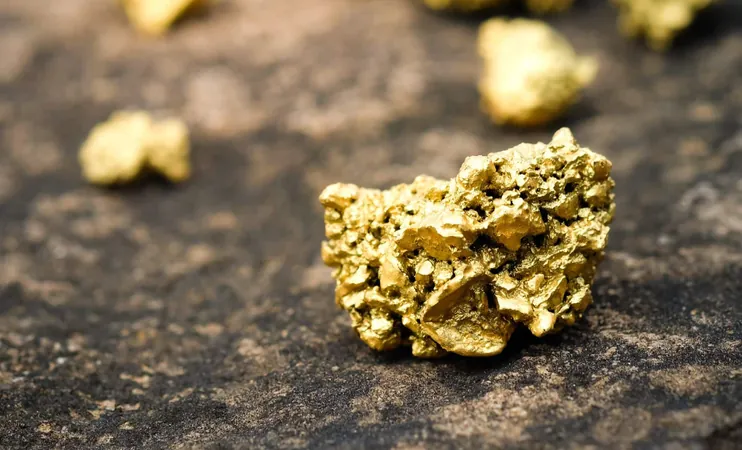
CERN Physicists Achieve Gold Creation from Lead—But Only for a Blink of an Eye!
2025-05-11
Author: Chun
Lead Transformed into Gold in Groundbreaking Experiment
In a stunning feat at CERN’s Large Hadron Collider (LHC), scientists have managed to transform lead into gold—albeit for just a fleeting moment! This modern twist on ancient alchemy occurred when high-energy lead ions smashed into each other, generating gold nuclei that existed only for a fraction of a second. Although we’re far from the age-old dream of producing pure gold, this achievement opens doors to significant scientific discoveries concerning particle interactions under extreme conditions.
A Scientific Leap in Alchemy
The long-desired goal of turning lead into gold has been pursued by alchemists for centuries. While the ancient practices fell short, today’s physicists, wielding high-tech particle physics tools, finally found a way to make it a reality. By accelerating lead ions to near light speed, the LHC triggers spectacular interactions leading to this remarkable transformation.
How the LHC Creates Fleeting Gold
Located near Geneva, Switzerland, the Large Hadron Collider conducts experiments that smash lead ions head-on, producing immense energy. In rare instances, these ions pass by each other closely enough to create an electromagnetic pulse, triggering one of the lead nuclei to eject protons and momentarily morph into gold, which has just 79 protons.
Over the years from 2015 to 2018, the ALICE collaboration at CERN documented an astonishing 86 billion gold nuclei being formed! Despite their minuscule mass of just 29 trillionths of a gram, these findings, published in 'Physical Review C', offer enlightening insights into nuclear physics.
The Science Behind the Magical Transformation
Understanding this atomic transformation requires a peek into high-energy physics. In these extreme scenarios, lead nuclei, supercharged by intense acceleration, interact through energy pulses unleashed during close encounters at the LHC. These energy surges can coax lead nuclei into shedding three protons, thereby crafting a gold atom.
But gold wasn’t the sole element crafted in these incredible collisions; thallium and mercury also emerged, albeit more plentiful. The precision of the ALICE detector allowed researchers to measure the ejected protons and neutrons, aiding in tracking the production of myriad elements.
The Elusive Existence of Gold
Although the gold created is fundamentally significant, it remains astoundingly rare. The total mass generated was a mere 29 picograms—too tiny for the naked eye to notice. These gold atoms were highly unstable, disintegrating within approximately one microsecond, making their existence a fleeting miracle before they collided with the collider's walls or decayed into other particles.
Despite yielding minuscule quantities, the implications of this experiment resonate greatly in the world of particle physics. It provided a platform for scientists to explore rare electromagnetic processes, revealing new ways particles behave under extreme circumstances. Physicist Uliana Dmitrieva stated, "Our findings mark the first systematic detection of gold production at the LHC and showcase our ability to capture such extraordinary events."
A New Chapter in Nuclear Transmutations
Though this method for generating gold is impractical, it astounds as a testament to what modern particle accelerators can achieve. The findings enhance our understanding of nuclear transmutation—the transformation of one element into another—not just from a scientific angle but also in terms of deepening our appreciation for nuclear interactions and particle collisions.




 Brasil (PT)
Brasil (PT)
 Canada (EN)
Canada (EN)
 Chile (ES)
Chile (ES)
 Česko (CS)
Česko (CS)
 대한민국 (KO)
대한민국 (KO)
 España (ES)
España (ES)
 France (FR)
France (FR)
 Hong Kong (EN)
Hong Kong (EN)
 Italia (IT)
Italia (IT)
 日本 (JA)
日本 (JA)
 Magyarország (HU)
Magyarország (HU)
 Norge (NO)
Norge (NO)
 Polska (PL)
Polska (PL)
 Schweiz (DE)
Schweiz (DE)
 Singapore (EN)
Singapore (EN)
 Sverige (SV)
Sverige (SV)
 Suomi (FI)
Suomi (FI)
 Türkiye (TR)
Türkiye (TR)
 الإمارات العربية المتحدة (AR)
الإمارات العربية المتحدة (AR)